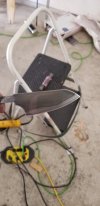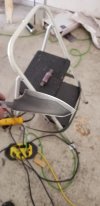- Joined
- Aug 3, 2011
- Messages
- 46
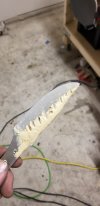
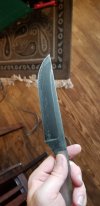
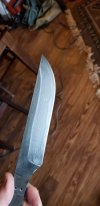 I have looked over all of the threads that I could find related to this issue, but I couldn't find one that explained my situation. I think the issue that I am having is with blistering but I am using an Evenheat kiln with precise temp control. So I was trying my hand at a temper line/hamon for the first time. I am using 1084 Aldo steel. I know that I am not going to get all that much activity but I wanted to test the process. I used Rutlands furnace mortar on 3/16 1084, no forging, only stock removal. I then heated the knife to 1500 degrees and soaked it for 5 minutes in an evenheat kiln, at which point I quenched it in canola oil and immediately tempered it at 400 degrees for two, two hour cycles. At this point I notices these small circles near where the clay stopped. I sanded the blade down to a 350 grit finish and test etched in ferric chloride, and saw that where those circles once were the etch did not take. So I re-sanded up to 550 to the point where the surface of the steel was 100% uniform and re-etched. While a was able to create a little but at a temper line the circles still etch differently and create and unwanted effect. I have attached photos of this issue. Any information on this would be greatly appreciated, as I am not sure at what step this might have been caused.
I have looked over all of the threads that I could find related to this issue, but I couldn't find one that explained my situation. I think the issue that I am having is with blistering but I am using an Evenheat kiln with precise temp control. So I was trying my hand at a temper line/hamon for the first time. I am using 1084 Aldo steel. I know that I am not going to get all that much activity but I wanted to test the process. I used Rutlands furnace mortar on 3/16 1084, no forging, only stock removal. I then heated the knife to 1500 degrees and soaked it for 5 minutes in an evenheat kiln, at which point I quenched it in canola oil and immediately tempered it at 400 degrees for two, two hour cycles. At this point I notices these small circles near where the clay stopped. I sanded the blade down to a 350 grit finish and test etched in ferric chloride, and saw that where those circles once were the etch did not take. So I re-sanded up to 550 to the point where the surface of the steel was 100% uniform and re-etched. While a was able to create a little but at a temper line the circles still etch differently and create and unwanted effect. I have attached photos of this issue. Any information on this would be greatly appreciated, as I am not sure at what step this might have been caused.


Last edited:

 understood, thank you for the awesome information. I will adjust my process with this in mind. You guys have been super helpful!!
understood, thank you for the awesome information. I will adjust my process with this in mind. You guys have been super helpful!!